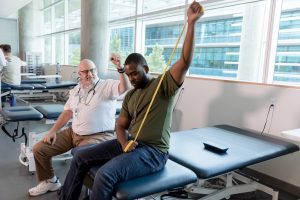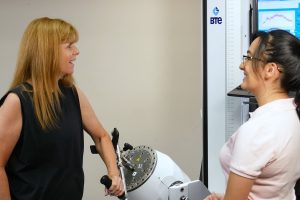
When and How To Screen for Hypermobility Disorders
Treatment GuidelinesYou may be the first practitioner to suspect and identify a hypermobility disorder in your client. Take a close look at how these conditions present and learn an evidence-based screening protocol.
Patients with joint hypermobility disorders may seek care from musculoskeletal care professionals. These specialists should be attentive to patient histories that suggest these disorders. They also should also know when and how to screen for skeletal hypermobility.
Your Patient
Your new patient is a 29-year-old female with chronic neck pain. She also reports a six-week exacerbation of left hip pain. She describes the hip as feeling like it’s “out of joint.” In the past, a provider could adjust it “back into place,” at least temporarily. Her past medical history includes irritable bowel disease, thoracolumbar scoliosis, and anxiety disorder. Several years ago, her PCP diagnosed her with fibromyalgia.
She recounts that she was an avid yoga practitioner for several years, and has always been “very flexible.” She had to discontinue yoga because of similar hip pain and instability. She used to dance ballet, but then had to stop when she experienced recurrent patellar dislocations. She would like your opinion on whether she should return to yoga. She would also like to know why she cannot get rid of her neck pain.
What clues do you now have? Given the above history, you might consider whether your patient has a skeletal hypermobility disorder.
What Are Hypermobility Disorders?
In hypermobility disorders, joint mobility in the spine and / or extremities exceeds typical ranges of motion. This condition can be specific to a particular region of the body, or generalized, to the entire body. While there are many different hypermobility disorders, they are all connective tissue disorders. In these patients, joint capsules, ligaments and / or other non-contractile tissues are lax or fragile.
Ehlers-Danlos syndrome (EDS) is one important hypermobility disorder. There are 13 current subtypes of EDS1. Most musculoskeletal specialists will see hypermobility-type EDS (hEDS) in their clinic.
Further criteria for EDS include joint pain, skin hyperextensibility (skin may be lifted excessively), and tissue fragility (easy bruising). A family history of generalized joint hypermobility is very common in EDS.
Patients with skeletal hypermobility who do not meet these additional criteria might instead be diagnosed with hypermobility spectrum disorder. These distinctions, however, are sometimes disputed2.
Life with a Hypermobility Disorder
Regardless of diagnostic category, a hypermobility disorder can affect your patient’s health broadly. For example, hEDS can present with a wide array of non-musculoskeletal symptoms. These include gastrointestinal and immunological abnormalities, and autoimmune disorders. For example, mast cell activation syndrome – when immune-response cells in a variety of tissues react excessively to chemical signals3. Unsurprisingly, asthma is also more prevalent in people with hEDS than without.
Poor sleep quality, chronic fatigue. and chronic pain are also very common in these disorders. Patients with fibromyalgia disproportionately exhibit hypermobility as well4. Anxiety, depression, and other psychological dysfunctions are also very common in EDS. These psychosocial deficits, together with the pain and fatigue, contribute to poor overall quality of life self-ratings in hEDS5.
Unfortunately, diagnosis of hEDS is often delayed, sometimes for many years6, further prolonging patients’ suffering. All forms of EDS are genetically acquired; but uniquely among them, the specific genetic pathology behind hEDS is unknown. This lack of gold-standard tests makes hEDS a diagnosis of exclusion. Therefore, the expertise to screen for hypermobility syndromes is crucial to minimize these delays in diagnosis.
When and How To Screen for Hypermobility
Your patient’s pain did not clearly fit into some other distinct disease category. In addition, a history of autoimmune disorders and / or gastrointestinal disorders should further raise suspicion. A history of longstanding flexibility and a family history of hypermobility are also suggestive. Patients may report a childhood history of dislocation of a shoulder or knee on more than one occasion.
A well-accepted screening protocol by Beighton and colleagues7 is easy to administer and score rapidly. Positive findings of the screen are:
- hyperextension of knees and elbows beyond 10 degrees;
- the ability to extend the 5th digits of the hand beyond 90 degrees;
- the ability to bring the thumb tips to the anterior aspect of the forearms;
- and the ability to bring the palms to the floor in front of the feet, without bending the knees.
Score by adding a point for each positive finding (each knee, elbow etc. is given one point). Depending on patient age (non-pathological hypermobility occurs more often in children), minimum scores four to six indicate clinically significant hypermobility.
Hypermobility in Your Clinical Practice
There is currently no cure for EDS or other hypermobility disorders. Many patients with hypermobility disorders receive medications to manage pain, such as NSAIDs, or second-line drugs such as amitriptyline. Devices such as braces can be useful for extremities requiring such stabilization. In addition, many patients can perform and likely benefit from physical exercise. A small number of clinical trials have reported on positive effects of exercise programs, with few adverse events reported8. These programs have generally focused on increasing strength, stamina, and / or lumbar spinal stability. No consensus or standard practice has evolved yet. Physical Therapists, Chiropractors, Athletic Trainers, and Occupational Therapists with relevant expertise can excel in helping people with this condition.
A diagnosis, positive screen, or simply suspicion of a hypermobility disorder may call for changes to manual treatment protocols. Joint hypermobility is generally considered to be a relative contraindication for thrust manipulation9. Finally, if there has been no formal diagnosis, consider referral to a geneticist for evaluation.
Peter Stein, PhD, DC
Peter Stein, PhD, DC, writes for both expert and general audiences on topics including neuromuscular and musculoskeletal diseases, chronic pain and pain management, sports medicine and orthopedics, and integrative healthcare. He is also a Chiropractor with a background in movement science, specializing in the treatment of chronic spinal degenerative diseases and neuromusculoskeletal problems of performing artists.
References
- Ehlers-Danlos Society. (2017, March 15). EDS Types. https://www.ehlers-danlos.com/eds-types/
- Aubry-Rozier, B., Schwitzguebel, A., Valerio, F., Tanniger, J., Paquier, C., Berna, C., Hügle, T., & Benaim, C. (2021). Are patients with hypermobile Ehlers–Danlos syndrome or hypermobility spectrum disorder so different? Rheumatology International, 41(10), 1785–1794. https://doi.org/10.1007/s00296-021-04968-3
- Seneviratne, S. L., Maitland, A., & Afrin, L. (2017). Mast cell disorders in Ehlers–Danlos syndrome. American Journal of Medical Genetics Part C: Seminars in Medical Genetics, 175(1), 226–236.
- Gensemer, C., Burks, R., Kautz, S., Judge, D. P., Lavallee, M., & Norris, R. A. (2021). Hypermobile Ehlers‐Danlos syndromes: Complex phenotypes, challenging diagnoses, and poorly understood causes. Developmental Dynamics, 250(3), 318–344.
- Rombaut, L., Malfait, F., Cools, A., De Paepe, A., & Calders, P. (2010). Musculoskeletal complaints, physical activity and health-related quality of life among patients with the Ehlers–Danlos syndrome hypermobility type. Disability and Rehabilitation, 32(16), 1339–1345.
- Levy, H. P. (1993). Hypermobile Ehlers-Danlos Syndrome (20301456). University of Washington, Seattle, Seattle (WA); PubMed.
- Beighton, P., Paepe, A. D., Steinmann, B., Tsipouras, P., & Wenstrup, R. J. (1998). Ehlers‐Danlos syndromes: Revised nosology, Villefranche, 1997. American Journal of Medical Genetics, 77(1), 31–37.
- Buryk-Iggers, S., Mittal, N., Santa Mina, D., Adams, S. C., Englesakis, M., Rachinsky, M., Lopez-Hernandez, L., Hussey, L., McGillis, L., & McLean, L. (2022). Exercise and rehabilitation in people with Ehlers-Danlos syndrome: A systematic review. Archives of Rehabilitation Research and Clinical Translation, 100189.
- Rombaut, L., Deane, J., Simmonds, J., De Wandele, I., De Paepe, A., Malfait, F., & Calders, P. (2015). Knowledge, assessment, and management of adults with joint hypermobility syndrome/Ehlers–Danlos syndrome hypermobility type among Flemish physiotherapists. American Journal of Medical Genetics Part C: Seminars in Medical Genetics, 169(1), 76–83.




